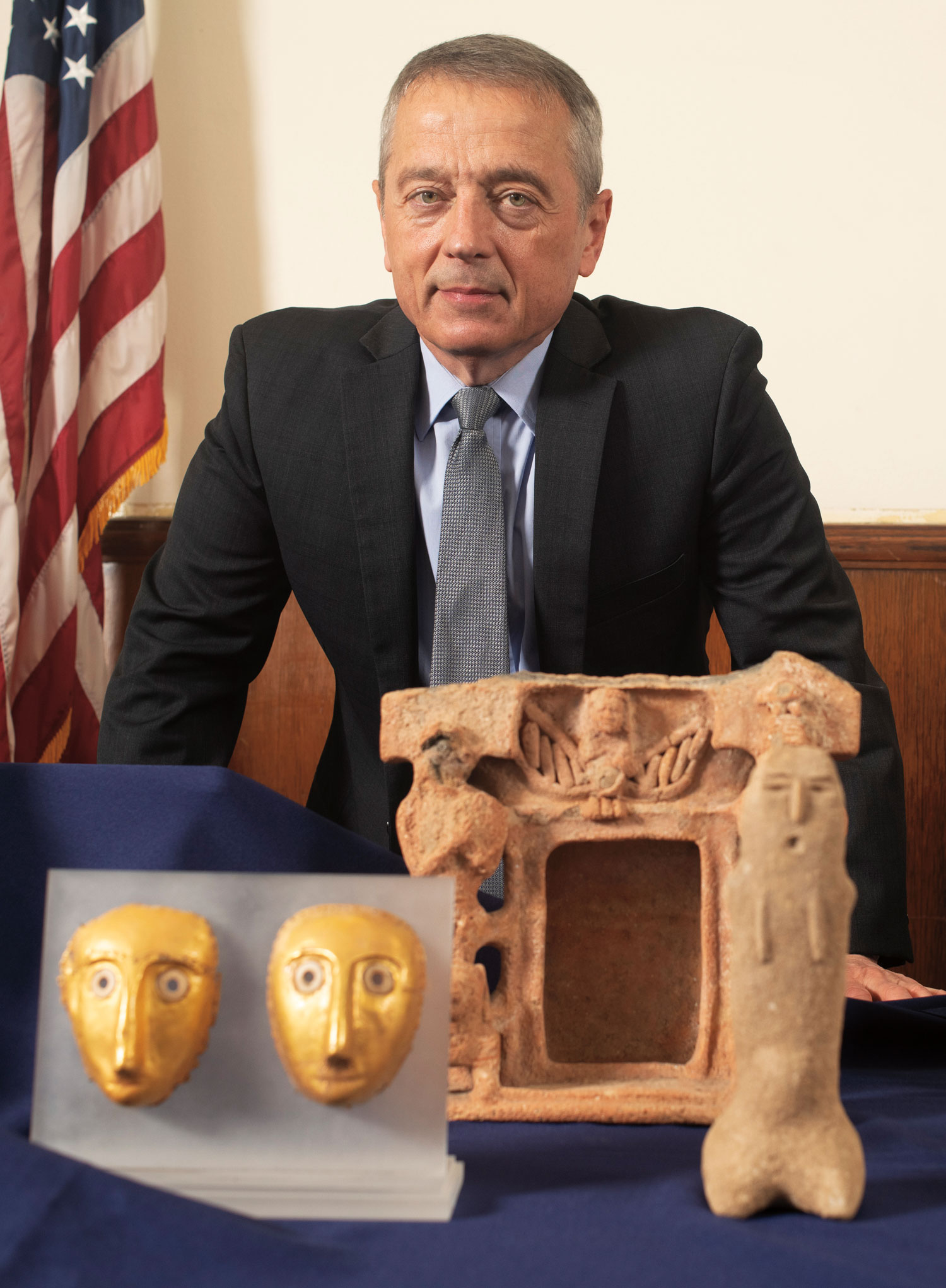
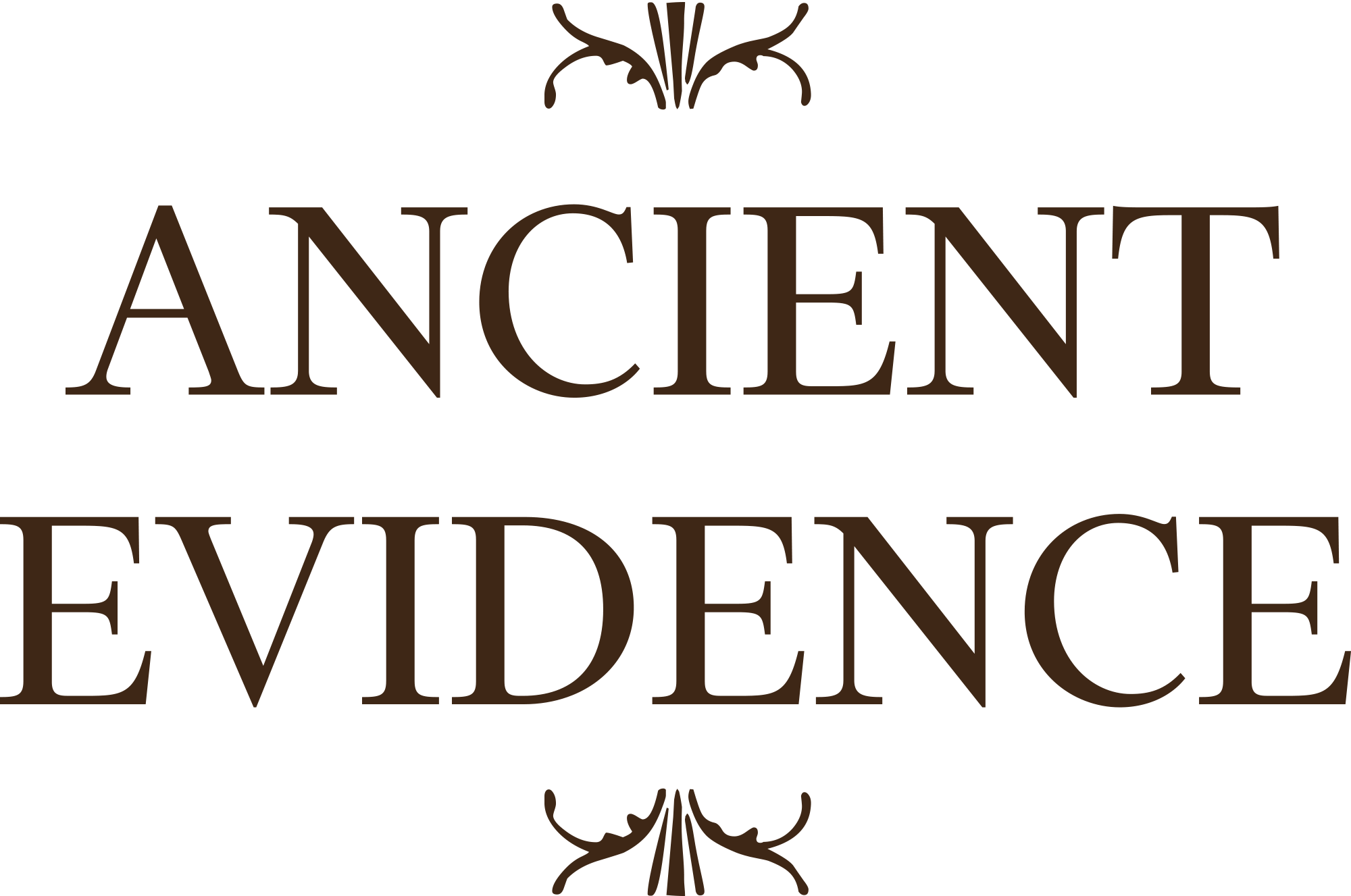
Ancient Evidence
Photographs by Barry Williams

n March 22, a small crowd of journalists and government officials from multiple countries gathered in New York City to admire a display of 28 antiquities from the ancient Middle East. The most precious of the items included two gold masks from around 5000 B.C., and three death masks from the neolithic era, between 6000 and 7000 B.C. But this ceremony, punctuated by speeches and the flashing of cameras, was not happening at the Metropolitan Museum of Art, Museum of Natural History or other cultural institution. It took place at the offices of the Manhattan district attorney, where the items had been temporarily removed from an evidence locker.
Valued at more than $5 million combined, the pieces on display were looted antiquities from Israel acquired by the hedge-fund billionaire and prominent art collector Michael Steinhardt. (Through lawyers, Steinhardt has said in the past that dealers had told him the items he purchased were lawfully acquired.) Now, they were being repatriated to Israel, due to the work of Assistant DA Matthew Bogdanos ’80, senior trial counsel and chief of the world’s first Antiquities Trafficking Unit.
“These extraordinary works are not just pieces of cracked alabaster or limestone or bronze,” Bogdanos says. “They are living, breathing testaments to our shared cultural heritage. They are a reminder of everything good in the world.”
Over the past decade, the Antiquities Trafficking Unit has seized almost 4,000 antiquities valued at more than $210 million. Nearly 1,800 have been returned to their homelands — including Greece, India, Pakistan, Cambodia, Nepal, Italy and Sri Lanka — with hundreds more scheduled to be repatriated this summer. They are an unlikely team of investigators — experts in art and archaeology working alongside detectives and special agents from the Department of Homeland Security. Bogdanos and his team have hand-delivered a $12 million statue to Beirut, raided the venerated Christie’s auction house in Rockefeller Center, and forced the Metropolitan Museum of Art to return a golden first-century-B.C. Egyptian coffin it had acquired for $4 million (a case breakthrough came after Kim Kardashian posed for a photo next to the coffin at the 2018 Met Gala).
Due to their work, museums, antiquities dealers and collectors have been forced to look more closely into the provenance of the items they acquire, when they might otherwise be tempted to overlook red flags.
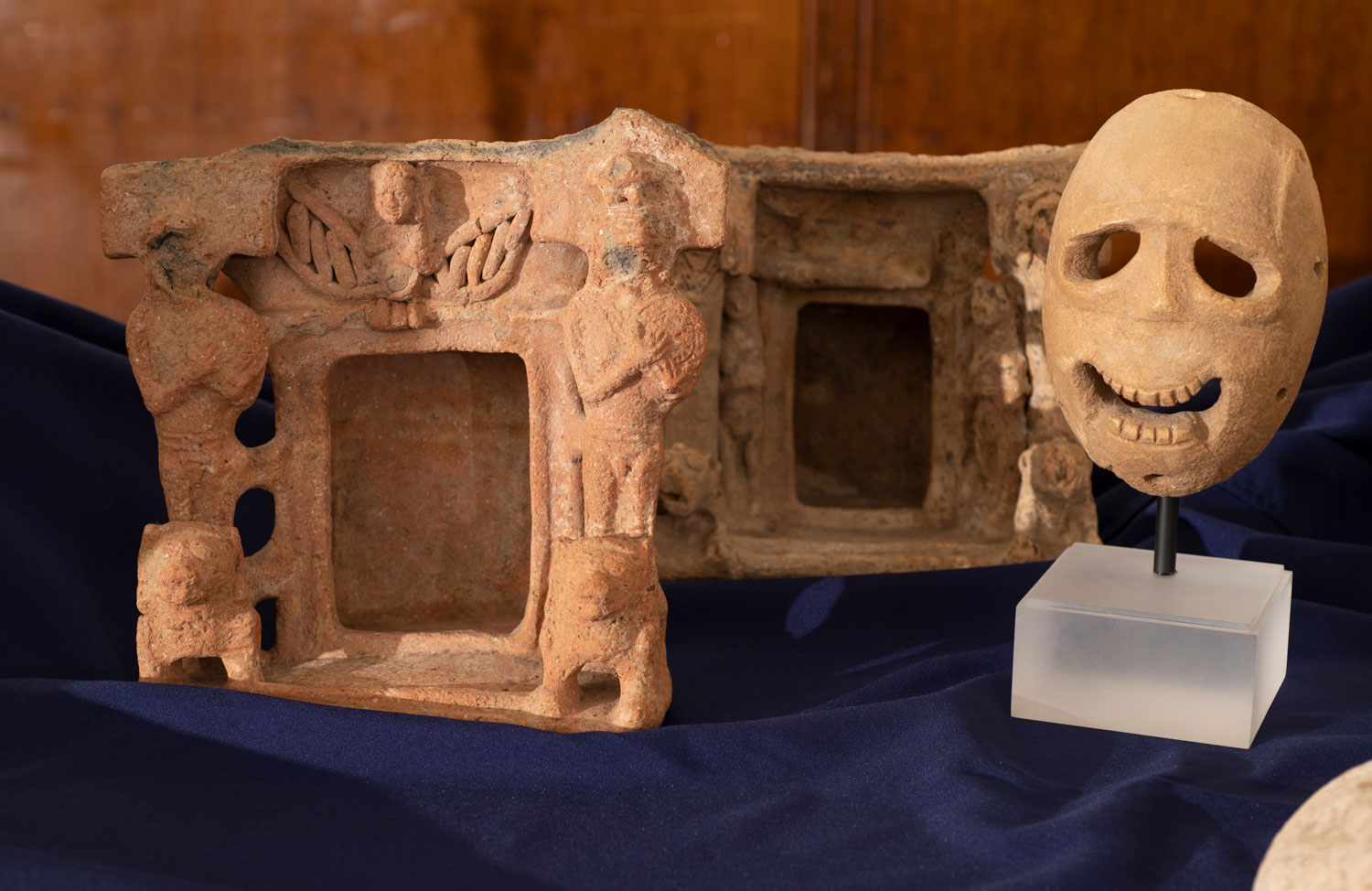
THE WARRIOR-SCHOLAR
As a restaurant kid, Bogdanos grew up expecting to go into the family business, and finished high school with no plans of attending college. It wasn’t until a few years after his graduation, when he tried to join the Marines, that a recruiter reviewed his test scores and advised Bogdanos to go to college so he could become an officer. He bought a book of college profiles, and in one long night, went through it page by page, narrowing down what he wanted in a university. He figured, based on his long-held affinity, he would major in classics, but he also wanted to play football, to not be in a city since he’d already grown up in one, and to go somewhere relatively small, because “I didn’t want to get swallowed up.” He settled on and applied to just one school: Bucknell.
The next day, he sent in a hand-written, 15-page letter — “I didn’t have a typewriter,” he says — explaining why he wanted to attend and asking to be considered even though he had missed the application deadline. The dean of admissions wrote back encouraging him to apply, and happily, Bogdanos was accepted. “He mentioned to me later on that it was literally the longest letter he had ever gotten, and I was so mortified,” Bogdanos recalls. He took Bucknell’s acceptance letter to his Marine recruiter and immediately joined the officer program.
Classically Trained
He became the first in his family to attend college, and his first time seeing the campus was the first day of class (he had skipped Orientation to work a last shift at the restaurant). Fortunately, he fell in love immediately: “It was everything I expected and wanted. It was exactly everything I thought college was supposed to be.”
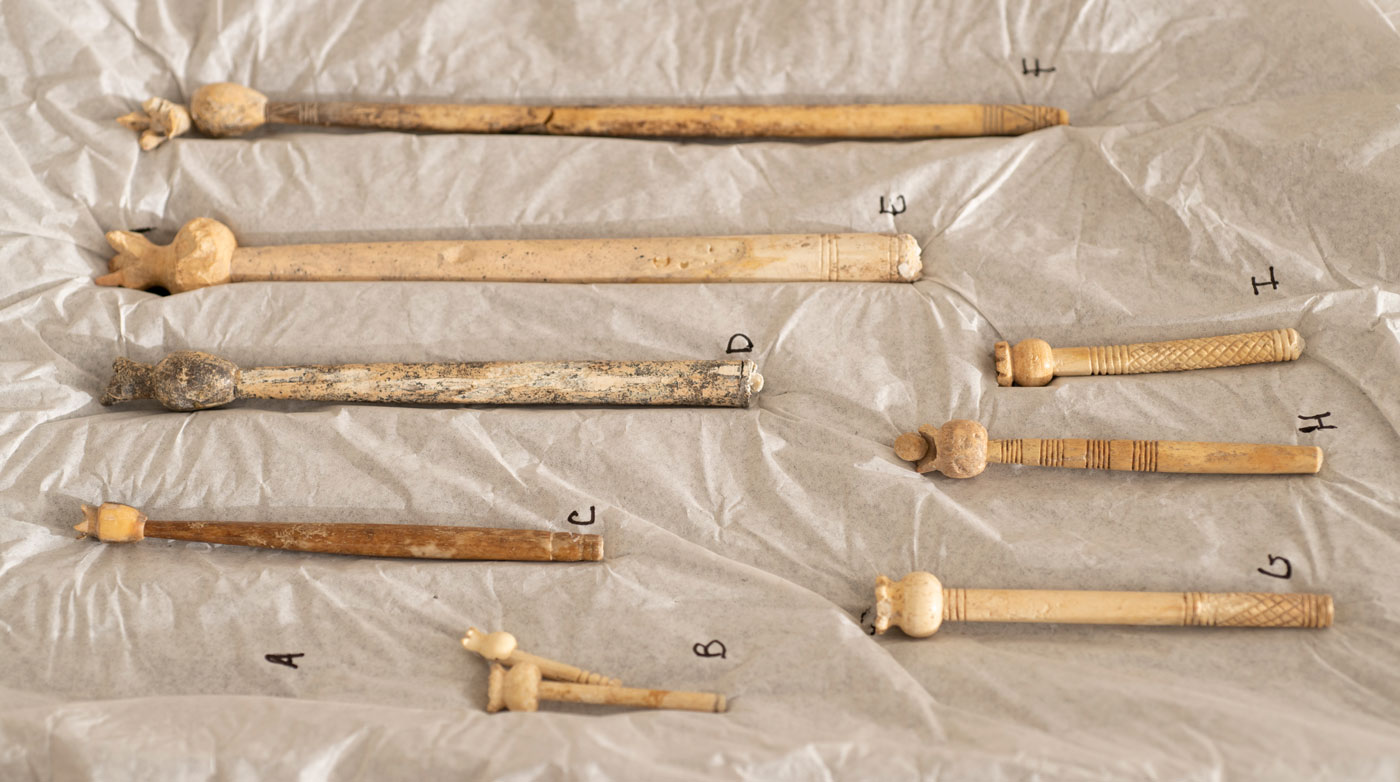

The DA’s office has seized 180 stolen antiquities valued at $70 million from billionaire art collector Michael Steinhardt, including 39 returned to Israel in March.
Bogdanos views antiquities on display during the March 22 repatriation ceremony.
Two gold masks dating from about 5000 B.C. are valued together at $500,000.
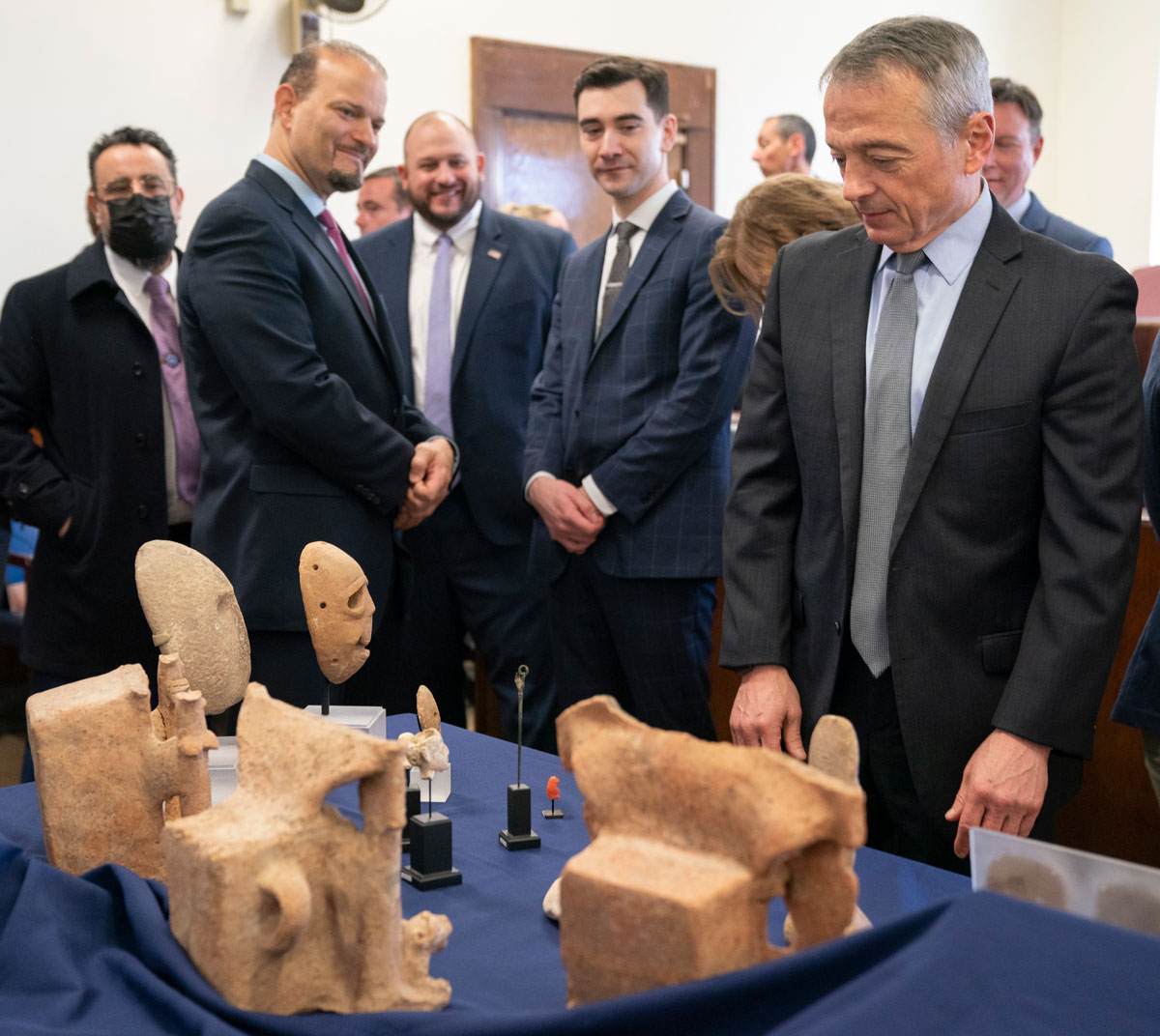
He played football, joined Sigma Chi, and started a boxing club. (Growing up, Bogdanos dreamed of becoming a boxer, and he still boxes today for fun and in charity events, many of them hosted by an organization he co-founded called Battle of the Barristers.) And, just as he’d planned, he studied classics.
Bucknell classics professors James Heath and Barbara Shailor were especially influential — to the extent that he took four or five classes from each of them. Professor Heath “was really old-school and taught me classical Greek, and I translated one of the books of the Iliad for one of his courses. It was just terrific,” Bogdanos recalls. Heath also advised Bogdanos on his honors thesis, which was about Alexander the Great. As for Professor Shailor, “she came at things from a much more holistic, psychological approach. We would do psychoanalysis of Greek tragedy, or look at how Jean-Paul Sartre or Friedrich Nietzsche interacts with Socrates or any of the Greek dramas.” Through all of these studies, Bogdanos was seeking — and firmly believes that he found — “a road map to how you’re supposed to live a life.”
THIEVES OF BAGHDAD
Bogdanos went on to complete a law degree and master’s at Columbia. That was followed by three years as a military lawyer at Camp Lejeune in North Carolina. In 1988, he left active duty to join the Manhattan DA’s office and became a homicide prosecutor, although he would continue to be deployed as a member of the Marine Corps Reserve, serving in Kosovo, Guyana, Kazakhstan and Operation Desert Storm.
On the fateful day of Sept. 11, 2001, Bogdanos was set on the path to his present-day role, hunting down looted antiquities. He was recalled to active duty and served in Afghanistan — where he earned a Bronze Star for combat actions against al-Qaeda and was promoted to colonel — then Iraq. In 2003, mere days after the U.S. invaded Baghdad, looters emptied Iraq’s national museum of approximately 14,000 priceless objects dating to the dawn of civilization, more than 7,000 years ago. By this point, Bogdanos had been appointed deputy director of the Joint Interagency Coordination Group, a team comprising counterterrorism agents from many different U.S. agencies. As detailed in his memoir, Thieves of Baghdad, Bogdanos requested permission to secure the museum with members of his team. Over the next few months, they managed to recover thousands of stolen antiquities, and eventually recovered almost 9,000 worldwide. Bogdanos was awarded a National Humanities Medal by President George W. Bush for his accomplishments.
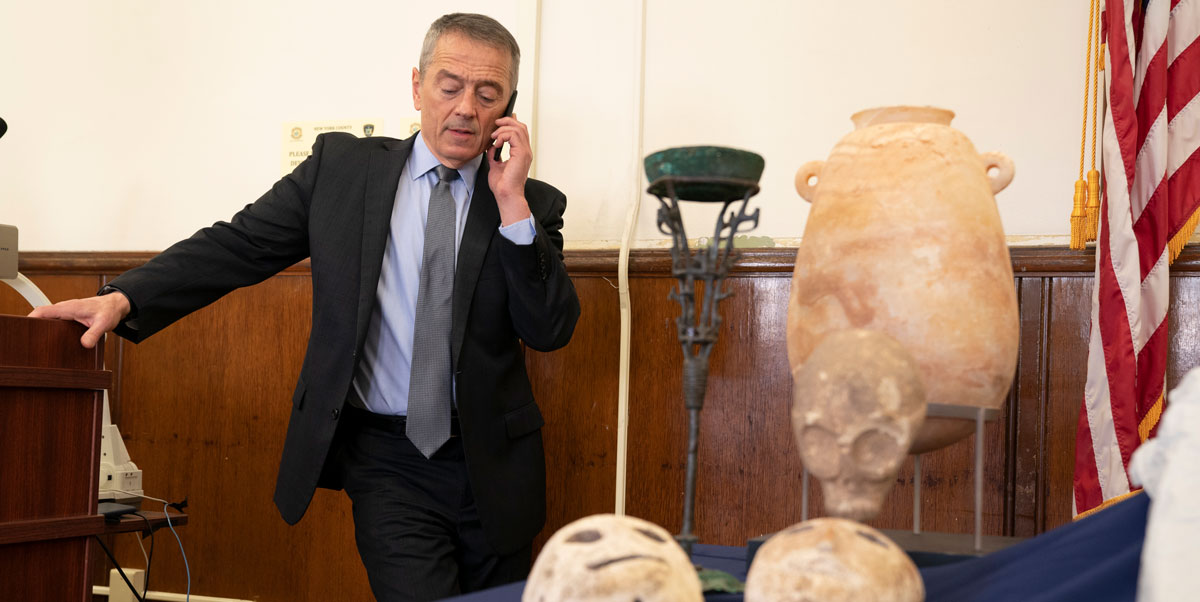
MANHATTAN TOMB RAIDER
In 2005, after being released from active duty and returning to his job as a prosecutor, Bogdanos made waves by pressuring the Manhattan DA’s office to create a task force dedicated to antiquities theft and trafficking — by announcing in The New York Times that it was already happening. He was shot down, but kept cultivating contacts in the antiquities world. After a new DA, Cyrus Vance, came into office, he eventually got to work on — and successfully prosecuted — a high-profile case involving suspicious rare coins from Italy. From there, Bogdanos found himself working on more and more cases involving antiquities until the formation of the Antiquities Trafficking Unit in 2017. He’s continued his role under new DA Alvin Bragg.
To be clear, prosecuting homicides remains the larger portion of Bogdanos’ workload — much of his time is spent on cases involving violent death, being “connected to the worst moment in people’s lives.” For that reason, he describes his work in the Antiquities Trafficking Unit as a source of “solace.” He also likes that, in his view, the work transcends politics and human conflicts. The unit has proudly returned antiquities to Iran, despite the U.S. not having normalized relations with the country, and to struggling nations that some would argue should not be entrusted with the stewardship of something so precious.
“When we recover an antiquity from Mesopotamia, whether it’s Iraq or Syria or Turkey, we’re recovering something that’s extraordinarily valuable and predates the split between Christianity and Judaism and Islam,” Bogdanos muses. “These objects that we recover resonate with every major world religion in the West.” In Southeast Asia, he adds, many looted antiquities come from small temples whose idols have been hacked from their pedestals, leaving villagers to worship before a replica or even a photograph of the idol. “It’s an outrage that is rivaled only by the sense of joy when we recover that item and return it,” he says.
For Bogdanos, however, those moments of joy are all too short.
“Every time you recover an antiquity, it’s a painful reminder to me that there are so many more out there,” he says. “Every time someone says congratulations to me at one of these [repatriation] ceremonies, I want to say, and frequently do say, ‘Thank you.’ But what I hear is, ‘You’re not done yet.’ ”